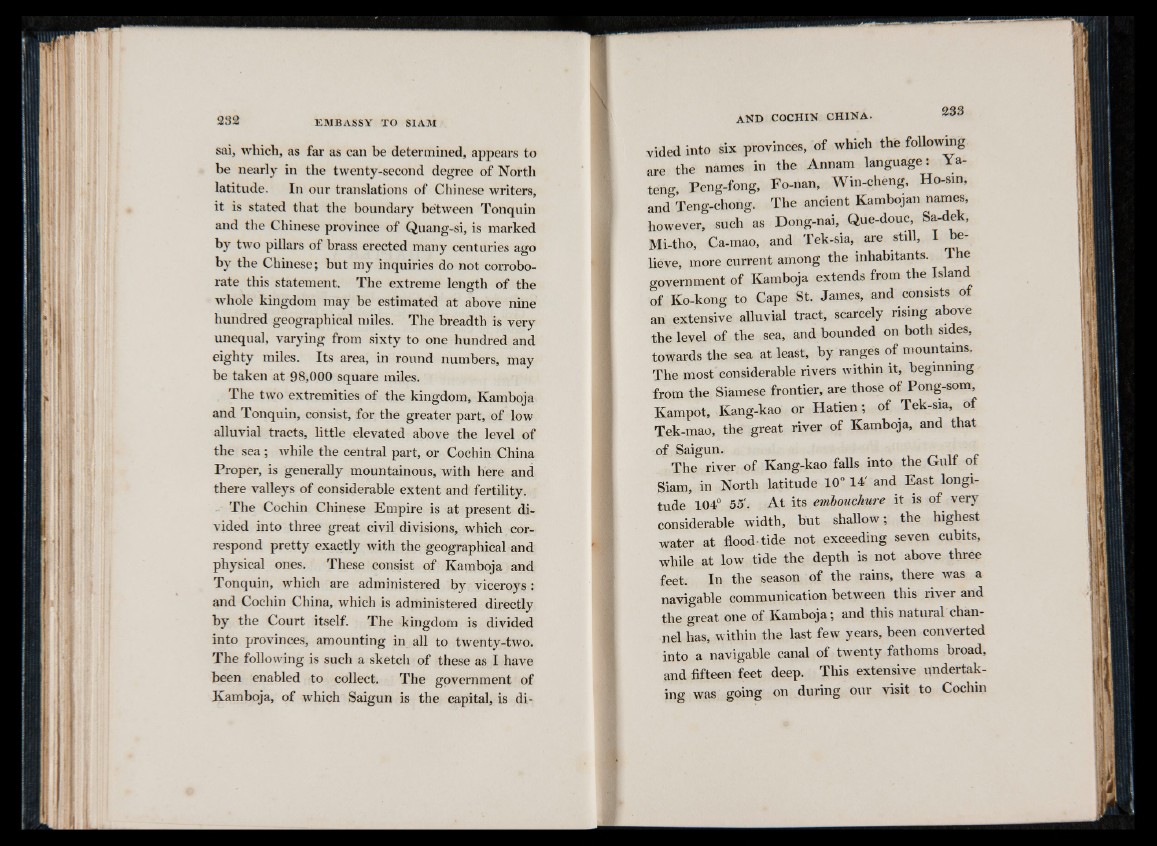
sai, which, as far as can be determined, appears to
be nearly in the twenty-second degree of North
latitude. In our translations of Chinese writers,
it is stated that the boundary between Tonquin
and the Chinese province of Quang-si, is marked
by two pillars of brass erected many centuries ago
by the Chinese; but my inquiries do not corroborate
this statement. The extreme length of the
whole kingdom may be estimated at above nine
hundred geographical miles. The breadth is very
unequal, varying from sixty to one hundred and
eighty miles. Its area, in round numbers, may
be taken at 98,000 square miles.
The two extremities of the kingdom, Kamboja
and Tonquin, consist, for the greater part, of low
alluvial tracts, little elevated above the level of
the sea ; while the central part, or Cochin China
Proper, is generally mountainous, with here and
there valleys of considerable extent and fertility.
The Cochin Chinese Empire is at present divided
into three great civil divisions, which correspond
pretty exactly with the geographical and
physical ones. These consist of Kamboja and
Tonquin, which are administered by viceroys:
and Cochin China, which is administered directly
by the Court itself. The kingdom is divided
into provinces, amounting in all to twenty-two.
The following is such a sketcli of these as I have
been enabled to collect. The government of
Kamboja, of which Saigun is the capital, is divided
into six provinces, of which thè following
are the names in the Annam language: Ya-
teng Peng-fong, Fo-nan, Win-cheng, Ho-sm,
and Teng-chong. The ancient Kambojan names,
however, such as Dong-nai, Que-douc, Sa-dek,
Mi-tho, Ca-mao, and Tek-sia, are still, I e‘
lieve, more current among the inhabitants. The
government of Kamboja extends from the Island
of Ko-kong to Cape St. James, and consists of
an extensive alluvial tract, scarcely rising above
the level of the sea, and bounded on both sides,
towards the sea at least, by ranges of mountams.
The most considerable rivers within it, beginning
from the Siamese frontier, are those of Pong-som,
Kampot, Kang-kao or Hatien ; of Tek-sia, of
Tek-mao, the great river of Kamboja, and that
of Saigun.
The river of Kang-kao falls into the Gulf of
Siam, in North latitude 10° 14' and East longitude
104° 55'. At its embouchure it is of very
considerable width, but shallow ; the highest
water at flood-tide not exceeding seven cubits,
while at low tide the depth is not above three
feet. In the season of the rains, there was a
navigable communication between this river and
the great one of Kamboja ; and this natural channel
has, within the last few years, been converted
into a navigable canal of twenty fathoms broad,
and fifteen feet deep. This extensive undertaking
was going on during our visit to Cochin